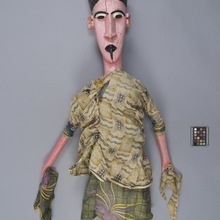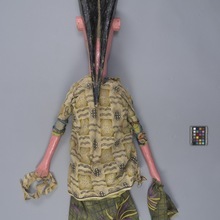Rod Puppet
MOA: University of British Columbia
3420/87
Female figure puppet with moveable arms, holding strips of fabric in each hand. The figure wears a black headdress or has black hair that is divided in the centre, with a raised bump on either side. She wears a light yellow-green patterned tunic with a ring structure sewn inside around the waist. She has painted bright pink skin, black and white eyes, black eyebrows, black lips and a black line down the chin. The figure lacks legs. There are control cords running down the length of the torso.
-
Narrative
Tchuemegne purchased these 20th century Sogobò puppets, textiles and frames (3420/79-100) from Mr. Amadou Fantasa, an elder from the village of Markala in central Mali, in 2019. Fantasa recalled that the puppets had been used in the biannual festivals marking the beginning of the rainy season (June), and related agricultural and fishing activities, and at the start of the dry season (Oct) to signal the coming of the grain harvest. He said the puppets had been in use from 2012-2016, but after that they were in storage. The "coming forth of the masks and puppets in Markala", frequently refered to as "Marakala Sogobò" or "Dobò", is now inscibed on UNESCO's List of Intangible Cultural Heritage.
-
History Of Use
Yayoroba puppet. A mobile stage is covered with cloths, concealing the men inside, who move the stage across the dance area. Fitted in front with a wooden animal head (an antelope or buffalo mask), the stage itself is a large puppet. The performances are organized by the village youth organizations, kamalen ton. Sogo bò is organized into a series of up to twenty discrete performances separated by short intervals of song and dance. Puppet ensembles include balanin fola (small rod puppets), merekun (large rod puppets), Yayoroba (beautiful women), and maani (smaller figurative forms). The puppet heads or figures poke out from the top of the cloth frame, and are made to twirl and dance as they tower above the stage. The puppets and masks depict animals, fantastic creatures, hunters and characters from village life. Short performances focus on themes of family and village rivalry, jealously and unity, as well as masculine values and their identification with hunters. Bamana farmers and Bozo fishermen participate together in these performances now, but the oral tradition suggests puppet theater originated with the Bozo.
- Type of Item puppet
- Culture Bozo, Bamana
- Material wood, fibre, paint, rubber
- Measurements height 104.0 cm, width 41.0 cm, depth 21.0 cm (overall)
- Previous Owner Richard Tchuemegne
- Received from Richard Tchuemegne, Michael O'Brian Family Foundation, Museum of Anthropology Exhibitions Budget
- Made in Segou
- Creation Date between 1950 and 2000
- Ownership Date before February 5, 2020
- Acquisition Date on February 5, 2020
- Condition fair
- Accession Number 3420/0087

